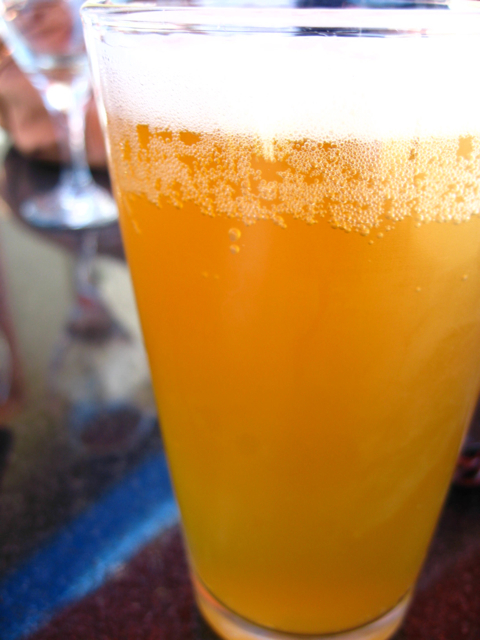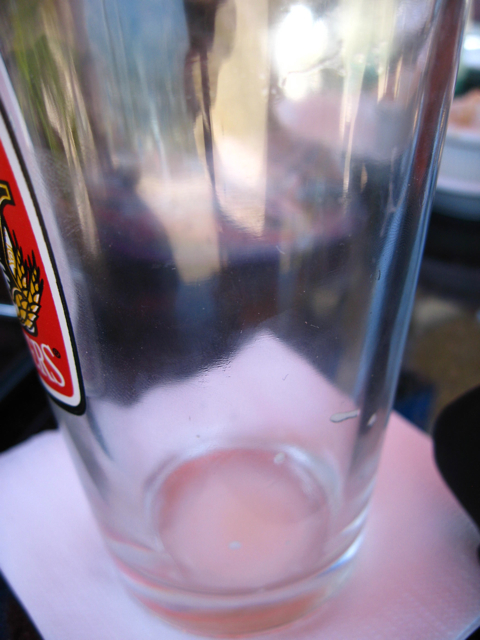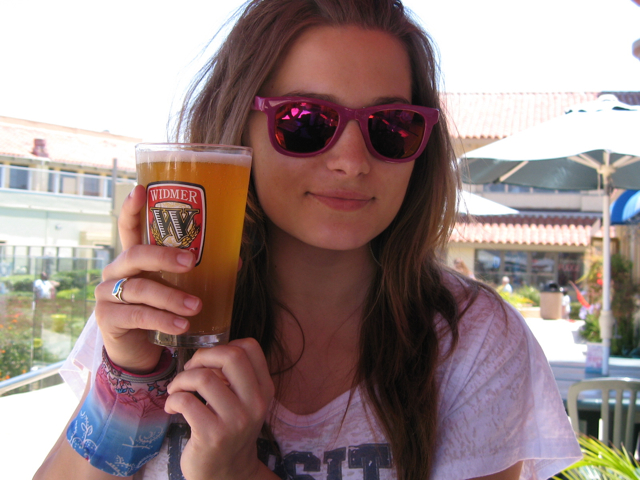I’ve been doing lots of studying on the beer front lately. Yesterday, I learned how to tap a keg (no, I never learned how to do that in college. I’m a late bloomer when it comes to beer…) and how to ensure that a glass is “beer clean”.
The term beer clean refers to a glass that is free of oils, dust particles or other impurities that would disturb the look and flavor of the beer. I set out yesterday to find a glass that was not beer clean so I could demonstrate for you.
 I did this for YOU.
I did this for YOU.
We went to Andres Wine and Tapas Bar over in Ventura Harbor yesterday to enjoy the gorgeous weather we’ve been having. I ordered a Widmer Hefeweizen with NO lemon or any kind of fruits on top. The citric acid and oils in the peel kill the head retention of the beer and also masks the true aroma and taste. Not the greatest (nor the worst) beer around, but it’s perfectly light and refreshing on a warm day!
 In the glass above, you’ll notice that there is a rim of bubbles close to the top of the glass, and not much head for a hefeweizen (a hef should have a fairly thick head that sticks around for a while). When a glass is not beer clean, the bubbles that cling to the sides will show you where any impurities are, and the head will not last as long as it should.
In the glass above, you’ll notice that there is a rim of bubbles close to the top of the glass, and not much head for a hefeweizen (a hef should have a fairly thick head that sticks around for a while). When a glass is not beer clean, the bubbles that cling to the sides will show you where any impurities are, and the head will not last as long as it should.
 In a beer clean glass, there will be an even ring of lacing down the sides as you drink the beer. Above, there are only a few random spots with any remnants of lacing.
In a beer clean glass, there will be an even ring of lacing down the sides as you drink the beer. Above, there are only a few random spots with any remnants of lacing.
 I got another, just to make sure that it wasn’t a random attack of regular dishwashing detergent. It wasn’t. The other glass did the same thing, but you can’t say I didn’t give them a fair shot! Again, I did this for YOU!
I got another, just to make sure that it wasn’t a random attack of regular dishwashing detergent. It wasn’t. The other glass did the same thing, but you can’t say I didn’t give them a fair shot! Again, I did this for YOU!
To get a beer clean glass, don’t even think about using detergent or regular soap. There are a few steps to ensure that you’ll pour a perfect pint every time.
1. Wash your pint class thoroughly with a sudsless soap and a clean bottle brush.
2. Dunk the glass in a sanitized sink full of cold water, making sure to put the bottom of the glass in first so you don’t get an air bubble in the glass which will prevent it from getting truly clean.
3. In another sink full of water and sanitizer, dunk the glass one more time, putting the bottom of the glass in first to ensure that all areas are being touched by the sanitizer.
4. Dry the glass upside down on a well aerated drying rack.
Seems easy enough, right? Here are some tests you can do to see if you’ve truly made that glass beer clean.
1. The Salt Test – rinse the clean glass in cold water and sprinkle table salt around the inside. Anywhere the salt doesn’t adhere to is not beer clean.
2. The Lacing Test – This is the test I chose. Pour a beer into a glass, drink that beer and see if there is any lingering lacing around the sides. If there’s not an even lacing from top to bottom, the glass is not beer clean.
 Salt Test on the left, Lacing Test on the right.
Salt Test on the left, Lacing Test on the right.
OKAY, enough learning for the day? I’ll finish up my recap.
After my study session at Andres Wine and Tapas bar, we sauntered over to Andria’s for some fried fish ‘n chips!
 Nothing like deep fried fish with an ocean breeze on the harbor on a warm summer day!
Nothing like deep fried fish with an ocean breeze on the harbor on a warm summer day!
 We also found the time to traumatize my dog. C’mon, how could I not???
We also found the time to traumatize my dog. C’mon, how could I not???

Don’t forget how the Bavarians can tell a clean glass and a good beer. Just look for the ring at each level after taking a drink. Sometimes you can have 3 or four rings, sometimes more. Depends on the size of the gulp!
That’s the basis for lacing as well. With a beer clean glass, there should always be multiple rings that remain after each sip. Exactly what you said!
One of my favorite bars uses a glass sprayer before each and every glass poured. It’s intended to remove all cleaning and sanitizing residue before the pour. If you pay attention you can tell the difference between this and other bars that don’t use it.
https://www.facebook.com/photo.php?fbid=10150203028483101&set=a.110178363100.98486.48931073100&type=1&ref=nf
Love it! Most of the places I go to do the same. I think whether or not they have it depends on how new a brewery or brewpub is. They don’t immediately think of these things sometimes.
Hi, i’m in love with you. Wanna get some homebrew beers in our beautiful Patagonia (Argentina)?
Bye!
Pingback: Library Alehouse | Bites 'n Brews
What kind of sudsless soap do you recommend? My uncle makes his own hard cider and said he uses sudsless soap to clean out new barrels but apparently the place he usually got his sudsless soap has stopped carrying it. I told him I’d look online for him but of course he couldn’t remember the name of the soap he once used. Do you know of a good sudsless soap that can be used?
I use Starsan – not quite a soap but a food-grade sanitizer that works wonders for sanitizing glassware. I’m not quite sure what to use for barrels though – let me look into it with the brewers I work with and get back to you!
We live in a drought area and work hard to conserve household water use. Is there a safe and sudsless dishpan detergent I can use without gloves? Popular dish liquids make lots of bubbles and it takes a lot of water to rinse. I add vinegar to the rinse water. I’d rather not deal with the foam, in the first place.